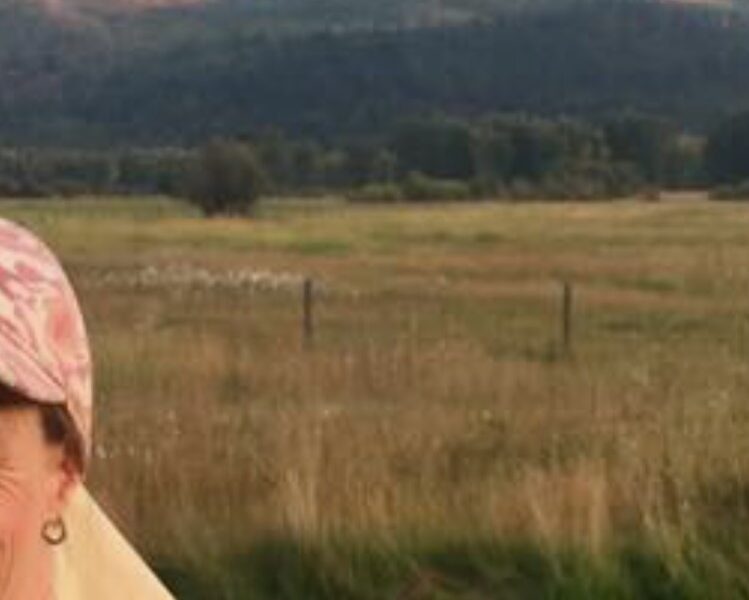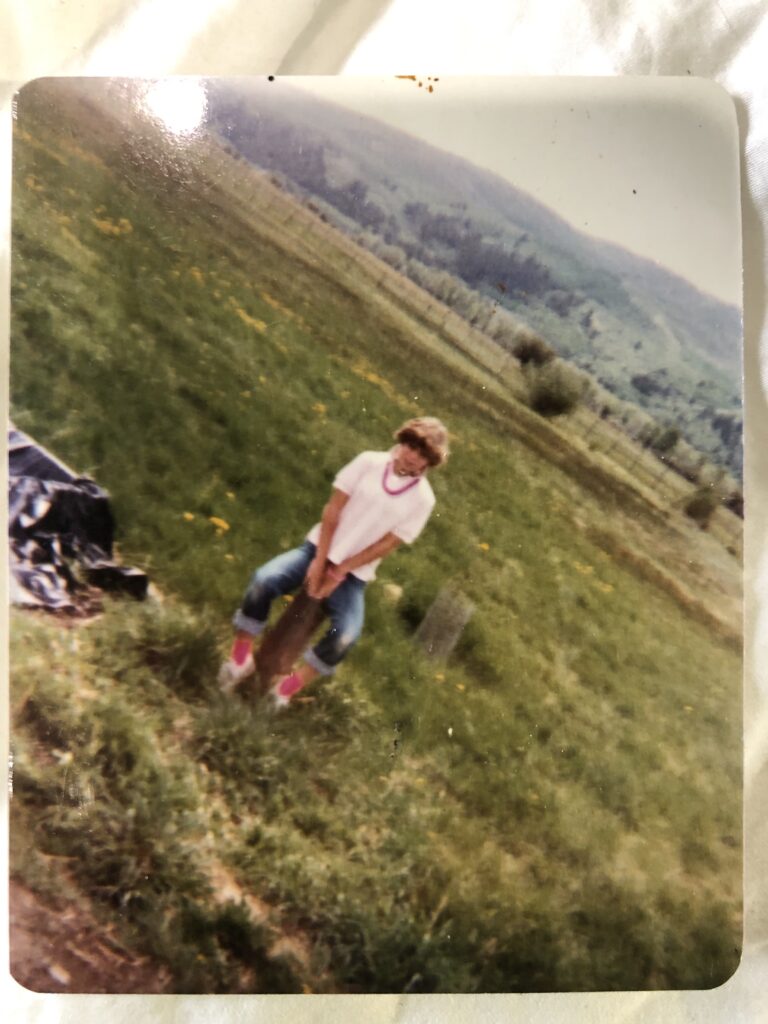The Lure of the Drink
How one Jackson Hole resident beat the bottle
- Published In: Other News & Features
- Last Updated: Oct 16, 2023

Pictured here is Nancy against the beautiful backdrop of Jackson. (Courtesy photo)
By Alec Klein
Special to the Wyoming Truth
Editor’s Note: This story is part of an ongoing series about substance use in Jackson Hole. It discusses alcoholism and self-harm. Reader discretion is advised.
Nancy is standing still in the kitchen, a portrait in repose: Big blonde bangs drape her freckled face. Braces fill her mouth. But something mars the picture. She’s weeping quietly.
From the loft above, her older brother peers at her and calls out: “What’s wrong? Why are you crying?”
She doesn’t know. She’s sad and apathetic. She feels alone and nothing. She’s frustrated and confused.
She’s 13.
Some personal stories are not based on a single dramatic life event but the subtle, imperceptible accumulation of layers and cuts. But there’s a starting point, when you can identify a discrete moment in time, a convergence of happenstance, DNA and the vectors of fate — and this is it for Nancy.
“When I was in it,” she recalls, “it was really difficult to see what it was… I started struggling with depression.”
Growing up amid the untamed beauty of Jackson, she becomes a petite teenager who’s forced to wear a painful, cumbersome back brace to deal with a congenital condition. The brace — a contraption of metal and plastic — pokes and prods. It wreaks her clothing. It makes her cry. Her mom cries in solidary with her.
Nancy battles with the demons, doubting her self-esteem. But it isn’t just because of the back brace. Too simplistic. There’s more. In school, she struggles with tests. She has trouble memorizing. She reads slowly. She tries hard but wrestles to comprehend.
“I thought I was stupid,” she says. “And I thought I was annoying.”
Nancy lives in a frugal home on a dead-end road where she spends a lot of time by herself. There are no kids down here. She doesn’t have anything to do. She gets into the craft of sewing. It’s something she can do on her own, in the back seat of the car, or anywhere else. She’s isolated wherever she goes, even when she’s among people. But in the solitude, there’s a tendency to lose perspective, to disconnect from the thread of your own life.
“I didn’t know how to respond emotionally,” she says. “I believed talking about yourself was arrogant. Talking about your struggles was self-pity. So, I didn’t do either of those. I shut down emotionally.”
This is, to an extent, a learned behavior. Her parents — middle class hippies, by her own reckoning — don’t complain. It’s a western Wyoming thing, too. Cowboy culture. Tough it out. Be stoic.

This is before she cuts herself. Before she wants to kill herself. Before she checks herself into a facility in Salt Lake City. This is when she’s 13 years old and she takes her first drink.
A wine cooler.
The disease of addiction
Nancy spoke to the Wyoming Truth on the condition of anonymity, using only her first name. Jackson, after all, is a small town. People talk. And such is the enduring stigma of alcoholism.
It’s a disease still fraught with mystery. “In many ways, alcoholism differs from most other diseases,” according to an abstract on The Natural History of Alcoholism by George E. Vaillant and Susanne Hiller-Sturmhöfel. “First, it generally develops slowly over a person’s life and can occur in people of all ages. Second, it has no single known cause: Heredity, culture, economics, and the environment all contribute to its development, and each alcoholic has his or her own personal drinking history.”
Alcoholism afflicts Jackson Hole particularly hard, despite the region’s reputation for the good life. Granted, it’s one of the richest patches on the planet, but it’s not only the playground of the uberwealthy. It’s a place forged by a huge service sector workforce that struggles with a dearth of affordable housing. Jackson’s per capita income is less than $50,000, according to U.S. Census figures. It doesn’t go far here.
It’s also a place wracked with substance abuse. The county boasts a higher percentage of adults reporting binge or excessive drinking than that of the state or nation, according to a report earlier this year. Over 20% — about one in five people in Teton County, home to the city of Jackson — reported excessive drinking. What’s more, 18% of motor vehicle crash deaths in Teton County involved alcohol.
And yet, despite the known substance use problems plaguing Jackson Hole, it doesn’t have the benefit of inpatient rehab services. For Nancy, she had to find another way out of her addiction.
Binge drinker
The youngest of three children, Nancy loves to spend time outdoors, skiing and biking. Hers is a life of God and family. They attend church on Sundays. She feels loved and supported.
There is, in her mind, no excuse.
But it happens anyway. She starts drinking. She’s 14 years old and hanging out with a couple of girls who are 16. Nancy is wearing her back brace. They’re drinking wine coolers. They decide to go over to a house to meet a couple of boys. The older girls leave Nancy in the living room, while they go off to hook up with the guys. Nancy doesn’t say a word. She acts like it’s normal. She feels like a grownup.
“It was cool to drink,” she says.
Within a couple of years, Nancy has moved onto hard liquor. She’s drinking with her older sister and her sister’s boyfriend. It’s fun. They’re laughing and having a good time. She’s being goofy. She feels like the center of attention. There is an ease and comfort — not being herself — as she imbibes, marinating in alcohol. She feels the lowering of inhibitions.
“That’s what it really became,” she says. “A way for me not to care what you thought. Not to feel ashamed of saying the wrong thing, acting the wrong way, worrying about that.”
That’s also when Nancy becomes what she calls a “binge drinker.”
She’s 16.
“If I drank, I drank to get drunk,” she says.
Nancy gets her hands on alcohol through friends. Friends of friends. At parties. Older people buy her alcohol. She raids the liquor cabinets of friends’ parents. A boyfriend takes her out on a date and brings her home stumbling drunk. He apologies to Nancy’s parents for getting her sloshed. It’s all out in the open. Her parents drink, too. Dad drinks beer. Mom is partial to wine. There’s family history, too. Her grandparents were alcoholics, she says.
What seems fun to Nancy soon devolves into something desperate. There’s no escaping how Nancy feels — “I would hate myself,” she says — and no amount of alcohol can drown it out.
It’s the summer after she graduates from high school, and there it is again: She doesn’t know what to do with herself. She’s isolated. She’s too inside her own head. Too self-conscious. She can’t find the energy to motivate herself. She tries to avoid people. She tries to find people to be with. Which is it? One isn’t enough. The other, too much.
“I needed time to myself, alone time, but if I didn’t have plans with other people, it would be too much,” she says.
Nancy wants to be responsible. She wants to be someone. She wants to be accountable and self-supporting. But at the same time, she doesn’t want to put in the effort. Which leaves her immobilized.
“I was a bystander,” she says.
That’s when she starts cutting herself. She doesn’t even know it is a common form of self-harm, a symptom of something serious. She deliberately pounds her head against her dresser.
“Just out of frustration,” she says. “Things just didn’t make sense.”
Nancy wants to kill herself.
She’s 18.
Now what? There’s only one thing to do.
Nighttime on a busy road
Doctors and her parents agree: Nancy suffers from depression. She checks into a facility in Salt Lake City for two stints, each for about two weeks. She’s on meds. She participates in group therapy. She meets with a therapist one-on-one. She doesn’t know why she wants to kill herself. Just that she does.
“Life is just too difficult,” she says. “It’s not worth it. It’s not worth the effort.”
That lingering feeling continues to haunt Nancy. She tries to fix whatever ails her but to no avail. She keeps feeling there’s no reason for what she feels, the despair. She can’t help but think she’s “an annoyance.”
It all comes to a head during her freshman year at Montana State University. Nancy’s drunk on wine. It’s nighttime on a busy road in Bozeman. And she’s standing in the middle of traffic, bottle in hand.
“I wanted to get run over,” she says.
She doesn’t remember much more, except that someone pulls her off the road to safety.
Nancy tries marijuana but it doesn’t take. Pot makes her self-conscious—the opposite of what she wants to feel. She wants to feel less of herself. She wants to escape from her reality. She doesn’t want to stand out. She wants to blend in. “I just wanted to get along and go along,” she says.
That means, for Nancy, more alcohol when she graduates from college. The plan is to become a fashion designer, perhaps a residue from her childhood when her back brace was a constant reminder of clothing that didn’t fit, that didn’t feel right. And though she secures a few gigs as a seamstress, ultimately Nancy gravitates to a different occupation: drinking.
She starts drinking every day. After work, she goes home and drinks gin and tonics. When she goes to the grocery store, heads out of town, or gets in the car, she cracks open a beer.
Nancy moves back to Jackson at the age of 26. She gets a job working in a deli, making sandwiches and smoothies. She also gets her own apartment. The one common denominator is the despair — not wanting to get out of bed, feeling miserable — and the drinking.
“I didn’t have to put on a happy face to be with anybody,” she says. “I could sit around and do nothing all I wanted to. I figured it was better to be depressed and alone than to be depressed with someone.”
There’s a regularity to the drinking until there isn’t. It becomes more sinister. Nancy becomes belligerent. “People started to not want to be around me when I drank,” she says.
She tells people to leave her alone—in more colorful language. She drinks so much, she ends up sleeping under a table. She’s so drunk, she lays down on the ground of a parking lot. She ditches whoever she’s with. “I was just a runner,” she says. “I just wanted to disappear.”
One night in Jackson, Nancy downs about six drinks—a mix of shots and beer. She gets behind the wheel of her Subaru and decides to become a racecar driver, gunning around a corner. The Subaru almost runs off the road. She sideswipes a sign, damaging her car.
Nancy is about 29.
Maybe, she figures she’s miserable enough that it’s time to do something about the drinking. A counselor tells her she’s on a bad path, given her personal history of alcohol use—and that of some of her family members. Perhaps, it’s time for her to consider trying something else.
The Big Book
It’s 8 o’clock on a Friday night in 2002, and Nancy enters a cramped dark room in a community center, an old school building, in nearby Wilson.
The first thing she notices: a bunch of happy faces. They welcome Nancy to a meeting of Alcoholics Anonymous—AA. They share their phone numbers. There’s no table. Everyone sits in a circle. Nancy has trouble admitting her problem. “I couldn’t admit I was an alcoholic,” she says. What she says is her name and “I have a desire not to drink.”
Nancy, working in a sales job in Jackson, says the same thing for months. But somewhere along the way, she remembers being in an AA meeting, thinking: “I am just not designed to drink.”
Alcohol is a depressant, and given her persistent depression, she concludes, “Drinking is not going to be helpful.”
She laughs at the recollection, as if it’s too obvious of a discovery. About six months into AA, she accepts that she’s an alcoholic. Also, she remembers thinking in an AA meeting that “God doesn’t want me to drink.”
AA, a free abstinence-based recovery program founded in 1935, doesn’t ask members to believe in any particular faith but in a God of your understanding—a higher power. The centerpiece of AA is a 12-step program infused with spirituality.
The 12 steps:
“1. We admitted we were powerless over alcohol — that our lives had become unmanageable.
2. Came to believe that a Power greater than ourselves could restore us to sanity.
3. Made a decision to turn our will and our lives over to the care of God as we understood Him.
4. Made a searching and fearless moral inventory of ourselves.
5. Admitted to God, to ourselves, and to another human being the exact nature of our wrongs.
6. Were entirely ready to have God remove all these defects of character.
7. Humbly asked Him to remove our shortcomings.
8. Made a list of all persons we had harmed, and became willing to make amends to them all.
9. Made direct amends to such people wherever possible, except when to do so would injure them or others.
10. Continued to take personal inventory and when we were wrong promptly admitted it.
11. Sought through prayer and meditation to improve our conscious contact with God as we understood Him, praying only for knowledge of His will for us and the power to carry that out.
12. Having had a spiritual awakening as the result of these Steps, we tried to carry this message to alcoholics, and to practice these principles in all our affairs.”
And thus, Nancy begins to return to her own spiritual roots—of church in her childhood and the enduring lessons from Jesus about love and forgiveness. Over time, this foundation of faith becomes a source of strength for Nancy. She gets an AA sponsor. She reads what’s called “The Big Book.” She works the 12 steps.
Nancy practically marries into the field; her husband is a recovering alcoholic as well. She has been sober since March 28, 2003. AA membership is supposed to be kept anonymous, especially in the media.
Twenty years later, Nancy lives on the land where she was raised in Jackson. She still dreams of making fashionable yet functional clothing for people. She still attends AA meetings. She remains vigilant. It’s never quite over, the addiction.
She’s 51.
“I’m not sober solely because of my effort,” she says. “I’m sober because of the grace of God.”













